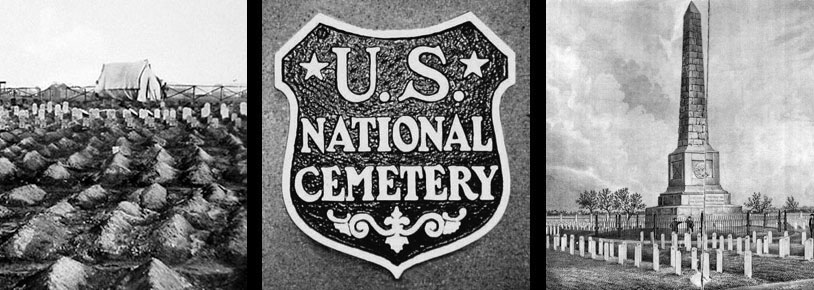

Civil War Era National Cemeteries: Honoring Those Who Served
Alexandria National Cemetery
Pineville, Louisiana
 |
Superintendent's Lodge, Alexandria National Cemetery Courtesy of the Department of Veterans Affairs, National Cemetery Administration, History Program |
The Red River runs from the northwest corner of Louisiana south, joining the Mississippi River 120 miles upriver from New Orleans. The city of Alexandria is strategically located on the Red River, roughly equidistant from Shreveport to the north and New Orleans to the south. During the Civil War, Shreveport was an important Confederate military headquarters, and its capture was a critical Union military goal. In 1864, Union Generals initiated the Red River Campaign to secure Shreveport and occupy east Texas. Union army and naval forces captured Alexandria in order to use the city as a supply center for their advances north to Shreveport. To supply their forces and deprive Confederate troops, Union troops took possession of livestock, cotton, tobacco, and food supplies in the Alexandria region. The Union’s Red River Campaign was ultimately unsuccessful due to a number of missteps, miscommunications, and infighting among the Union commanders that led to a series of military losses to the smaller Confederate force. When Union forces retreated south to New Orleans, they set Alexandria ablaze, destroying the city.
Two years after the Civil War, in 1867, the U.S. government purchased 8.2 acres from local resident François Poussin to establish a national cemetery. The property, located east of Alexandria in the town of Pineville, became the final resting place for Union soldiers who had died in battle during the Red River Campaign. The military transferred the remains from sites at Cotile Landing, Fort De Russy, Yellow Bayou, Pleasant Hill, and other campaign battlefields. They also moved fallen Union soldiers originally buried in Jefferson and Tyler, Texas, to the Alexandria National Cemetery.
In 1909, the United States Army abandoned Fort Brown, Texas, and its associated Brownsville National Cemetery. The U.S. government contracted a private firm to transfer and reinter the remains of 3,800 soldiers from Brownsville National Cemetery to Alexandria National Cemetery. Most of the soldiers originally interred at Brownsville were casualties of the Mexican-American War, the Civil War, and an 1885-86 yellow fever epidemic. Major Jacob Brown, for whom the fort was named, is now buried at Alexandria. One grave at Alexandria contains the remains of 1,537 unknown soldiers originally buried at the Brownsville Cemetery.
 |
Rostrum, Alexandria National Cemetery Courtesy of the Department of Veterans Affairs, National Cemetery Administration, History Program |
Alexandria National Cemetery is the final resting place of many “Buffalo Soldiers.” These soldiers served in the 24th and 25th Infantries, in addition to the 9th and 10th Cavalries formed just after the Civil War; both were important assets during the Indian Wars of the late 1800s. These regiments, as well as later segregated regiments, also saw service in the Spanish-American War, World War I and World War II. The U.S. military began to desegregate its forces in 1952.
The buildings and structures on the cemetery grounds—a superintendent’s lodge, utility building, main gate, and rostrum—date to the 1930s. One exception is the cemetery’s brick perimeter wall, which was constructed in 1878.
The one-story Colonial Revival superintendent’s lodge, located just inside the cemetery’s front gate, dates from 1931 and is the replacement for a two-story brick house built in 1879. The brick utility building, located in the southwest corner of the cemetery, was built in the 1930s, with an addition constructed in 1940. Near the center of the cemetery stand a flagpole and a rostrum. The 1931 rostrum is simple in design, featuring a raised concrete platform with a railing of pipe posts and wrought iron.
Within the grounds of the cemetery lies a marble marker, six inches square and set three inches above the ground, inscribed with “U.S.C. & G.S.” Laid by the U.S. Coast and Geodetic Survey in April 1901, some accounts claim that the marker denotes the geographic center of the state. However, the marker is actually a magnetic station that served as a reference point for surveyors calculating the difference between true and magnetic north. Today, these markers are rare, as technological advances have made these stations obsolete.
| Plan your visit |
Alexandria National Cemetery is located at 209 East Shamrock St. in Pineville, LA. The cemetery is open for visitation Monday-Friday from 8:00am to sunset; the administrative offices are open Monday-Friday from 8:00am to 4:30pm, and are closed on all Federal holidays except for Memorial Day and Veterans Day. For more information, please contact the cemetery offices at 318-449-1793, or see the Department of Veterans Affairs website. While visiting, please be mindful that our national cemeteries are hallowed ground. Be respectful to all of our nation’s fallen soldiers and their families. Additional cemetery policies may be posted on site. Alexandria National Cemetery was photographed to the standards established by the National Park Service’s Historic American Landscapes Survey. |